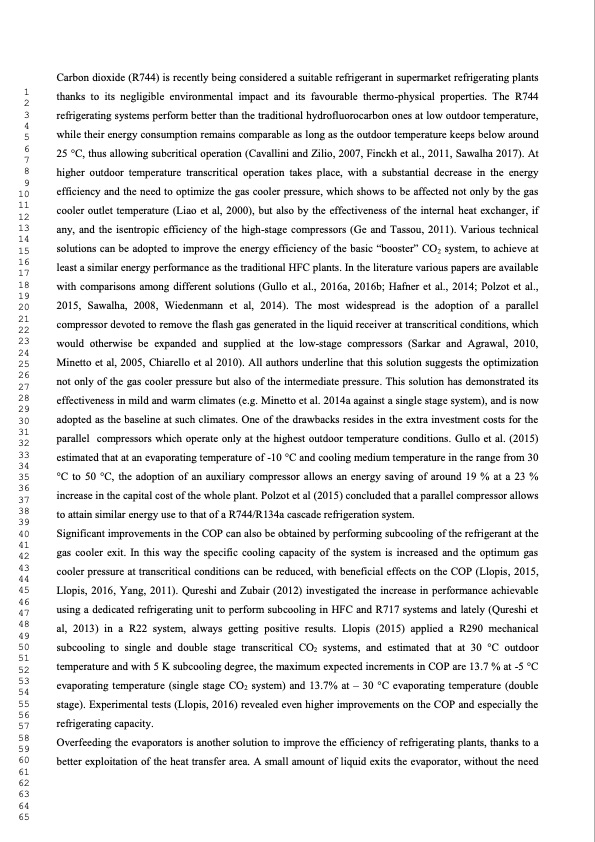
PDF Publication Title:
Text from PDF Page: 003
Carbon dioxide (R744) is recently being considered a suitable refrigerant in supermarket refrigerating plants thanks to its negligible environmental impact and its favourable thermo-physical properties. The R744 refrigerating systems perform better than the traditional hydrofluorocarbon ones at low outdoor temperature, while their energy consumption remains comparable as long as the outdoor temperature keeps below around 25 °C, thus allowing subcritical operation (Cavallini and Zilio, 2007, Finckh et al., 2011, Sawalha 2017). At higher outdoor temperature transcritical operation takes place, with a substantial decrease in the energy efficiency and the need to optimize the gas cooler pressure, which shows to be affected not only by the gas cooler outlet temperature (Liao et al, 2000), but also by the effectiveness of the internal heat exchanger, if any, and the isentropic efficiency of the high-stage compressors (Ge and Tassou, 2011). Various technical 14 solutions can be adopted to improve the energy efficiency of the basic “booster” CO system, to achieve at 15 2 1 2 3 4 5 6 7 8 9 10 11 12 13 16 17 18 19 20 2015, Sawalha, 2008, Wiedenmann et al, 2014). The most widespread is the adoption of a parallel 21 57 58 59 60 61 62 63 64 65 least a similar energy performance as the traditional HFC plants. In the literature various papers are available with comparisons among different solutions (Gullo et al., 2016a, 2016b; Hafner et al., 2014; Polzot et al., compressor devoted to remove the flash gas generated in the liquid receiver at transcritical conditions, which would otherwise be expanded and supplied at the low-stage compressors (Sarkar and Agrawal, 2010, 22 23 24 25 Minetto et al, 2005, Chiarello et al 2010). All authors underline that this solution suggests the optimization 26 not only of the gas cooler pressure but also of the intermediate pressure. This solution has demonstrated its 27 28 29 30 adopted as the baseline at such climates. One of the drawbacks resides in the extra investment costs for the 31 effectiveness in mild and warm climates (e.g. Minetto et al. 2014a against a single stage system), and is now parallel compressors which operate only at the highest outdoor temperature conditions. Gullo et al. (2015) 32 33 34 35 °C to 50 °C, the adoption of an auxiliary compressor allows an energy saving of around 19 % at a 23 % 36 estimated that at an evaporating temperature of -10 °C and cooling medium temperature in the range from 30 increase in the capital cost of the whole plant. Polzot et al (2015) concluded that a parallel compressor allows 37 38 39 40 Significant improvements in the COP can also be obtained by performing subcooling of the refrigerant at the 41 to attain similar energy use to that of a R744/R134a cascade refrigeration system. gas cooler exit. In this way the specific cooling capacity of the system is increased and the optimum gas 42 43 44 45 Llopis, 2016, Yang, 2011). Qureshi and Zubair (2012) investigated the increase in performance achievable 46 cooler pressure at transcritical conditions can be reduced, with beneficial effects on the COP (Llopis, 2015, using a dedicated refrigerating unit to perform subcooling in HFC and R717 systems and lately (Qureshi et 47 48 49 50 subcooling to single and double stage transcritical CO2 systems, and estimated that at 30 °C outdoor 51 al, 2013) in a R22 system, always getting positive results. Llopis (2015) applied a R290 mechanical temperature and with 5 K subcooling degree, the maximum expected increments in COP are 13.7 % at -5 °C 52 53 54 55 stage). Experimental tests (Llopis, 2016) revealed even higher improvements on the COP and especially the 56 refrigerating capacity. Overfeeding the evaporators is another solution to improve the efficiency of refrigerating plants, thanks to a better exploitation of the heat transfer area. A small amount of liquid exits the evaporator, without the need evaporating temperature (single stage CO2 system) and 13.7% at – 30 °C evaporating temperature (doublePDF Image | R744 BOOSTER INTEGRATED SYSTEM

PDF Search Title:
R744 BOOSTER INTEGRATED SYSTEMOriginal File Name Searched:
rj34_sub.pdfDIY PDF Search: Google It | Yahoo | Bing
CO2 Organic Rankine Cycle Experimenter Platform The supercritical CO2 phase change system is both a heat pump and organic rankine cycle which can be used for those purposes and as a supercritical extractor for advanced subcritical and supercritical extraction technology. Uses include producing nanoparticles, precious metal CO2 extraction, lithium battery recycling, and other applications... More Info
Heat Pumps CO2 ORC Heat Pump System Platform More Info
| CONTACT TEL: 608-238-6001 Email: greg@infinityturbine.com | RSS | AMP |